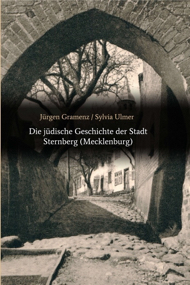The Jewish History of the Town Sternberg (Mecklenburg)
Die jüdische Geschichte der Stadt Sternberg (Mecklenburg)
(The Jewish History of the Town Sternberg (Mecklenburg))
Jürgen Gramenz / Sylvia Ulmer
Hamburg 2015
Verlag tredition
DIN A4
456 pages
74 pictures
Hardcover: ISBN 978-3-7323-4812-1
Paperback: ISBN 978-3-7323-4811-4
eBook: ISBN 978-3-7323-4813-8
Purchase options:
Verlag tredition


Dedicated to the Jews of Sternberg.
Especially for Ernst, who probably would have been very happy about it.
For Jane, Susan, Sally, Simon, René, Steven und all the others, who have here their roots.
Content
The town Sternberg in Mecklenburg is still today connected to an incident that happened 500 years ago, when Jews in the year 1492 were charged with Eucharistic Sacrilege a fictious crime used in Jewish progroms. 27 Jews were burned alive on the Judenberg, the place named after those who died there. All Jews in Mecklenburg were expulsed and for the next 200 years no Jews were allowed to live in Mecklenburg.
The aim of this book is to straighten out this one-sided view of the Jewish history in Sternberg.
No publication about this city can avoid accepting the omnipotent topic and this book is no exception. The book provides a comprehensive overview about how legends were formed, the argumentation to the evidence, the subsequent reception of the desecration of the host process (Eucharistic Sacrilege) in Literature. All this gives us a deeper insight of the ruling perception concerning the Jewish neighbours at that time and to the incident itself.
The main part of the book definitely deals with what came therafter, dealing with the Jewish resettlement in Sternberg and the Jewish life in town. To enable such a reconstruction, the whole city archive, more than 1000 pages were evaluated and transcribed. The result of this work is the basis of this book. It was the only way to be able to represent the Jewish community of Sternberg, it’s beginnings, the first Schutzjuden (letters of protection) who resettled at the end of the 18th century. The book vividly describes the difficulties and highlights that unquestionably occurred with the construction of the synagogue in Sternberg 1853-55, the gradual demise and efforts of disintegration by the Israelite Oberrat (highest Jewish authority) and the government of Mecklenburg, until Nazism gave the ultimate deathblow to everything Jewish in Sternberg. As a result of that, the town became "Judenrein" in the year 1940.
Numerous pictures of Jewish citizens and their surroundings are available, among them the only two still existing photos of the 1937 demolished synagogue. Many illustrations complement the textual essay and shows clearly that Jews were an integral part of the city.
An extensive part of the book includes Jewish life in Sternberg, the development of the Jewish population since the 18th century, the relations among themselves , also to their non-Jewish neighbours, their contribution to city life and the military, their contribution to trade and industry in the immediate and also to the wider area of Mecklenburg. In addition to the above mentioned, the cause of emigration is viewed from a larger sociological standpoint down to the smaller frame of each family.
The genealogies of all former Jewish families are almost all completely displayed and emphazises their development and the whereabouts of family members. The Jewish families who lived here includes the families Ahrens (Nathan), Ahrens (Josephy), Behrens, Bentzien, David, Freudenfeld, Kychenthal, Löwenthal, Rosenbaum and Waldheim. Trough marriage more Jewish families received references to the city, e.g. families Amsberg, Cohn, Frank, Friedländer, Gowa, Hirsch, Josephy, Lazarus, Levy, Loeb, Marcus, Müller, Nord, Philipps, Rosenberg, Samuel, Seckel, Simonis, Valk, van Damm and Würzburg.
Among these families personalities can be found such as Hermann Kychenthal, the lesser known twin brother to Louis Kychenthal the Jewish owner of a department store in Schwerin. Also Rachel Rosenbaum the prime example of a fallen woman, who during imperial time was disgraced and robbed of all opportunities and ended on the wrong path. Add to that the three unmarried sisters from the Bentzien family, jocularly called “Malefiteline”. Another representative of the Jewish congregation was Adolph Rosenbaum, who in righteous anger broke the arm of a young man. There are the merchants David Davidson and Louis Rosenbaum, who as the principals of the Jewish community successfully maneuvered the community through turbulent times.
The conclusion is inevitably the time of Nazism. The entire period during which the Jewish citizens of Sternberg is illuminated, starting with the beginning of racist reprisals, the escape abroad up to the murder in those well-known deathcamps in the east. The book thus provides a complete overview of the victims in the Shoa, who had relations to the town, to the Jewish citizens, to their relatives and partially also to the former Jewish students from the College of Technology in Sternberg. In addition to the individual fates of persons, there is a documentation of Jewish firms from Sternberg regarding their Aryanisation. The important Country Trading Company Löwenthal, the firms Nord &Co. and Josephy & Ahrens. The firm Nord & Co.,was established in 1854.
The historical presentation is supplemented with an annex, which contains important documents from Jewish history in Sternberg, e.g. the original proclamation of hereditary surnames from April 23th 1813, also included is the text of the long-term lease concerning the Jewish cemetery from 1825. In addition to that, the annex contains the draft of the Municipal Code for Sternberg, created by their members in February 1840. A Municipal Code issued for the Jews by the Grand Duke in 1846 was not accepted. There are more transcribed documents included. The annex has an almost complete list of community leaders, including accounts, patrons and religion teachers of the Jewish community in Sternberg. This publication is meant as an additional contribution to the history of Sternberg.